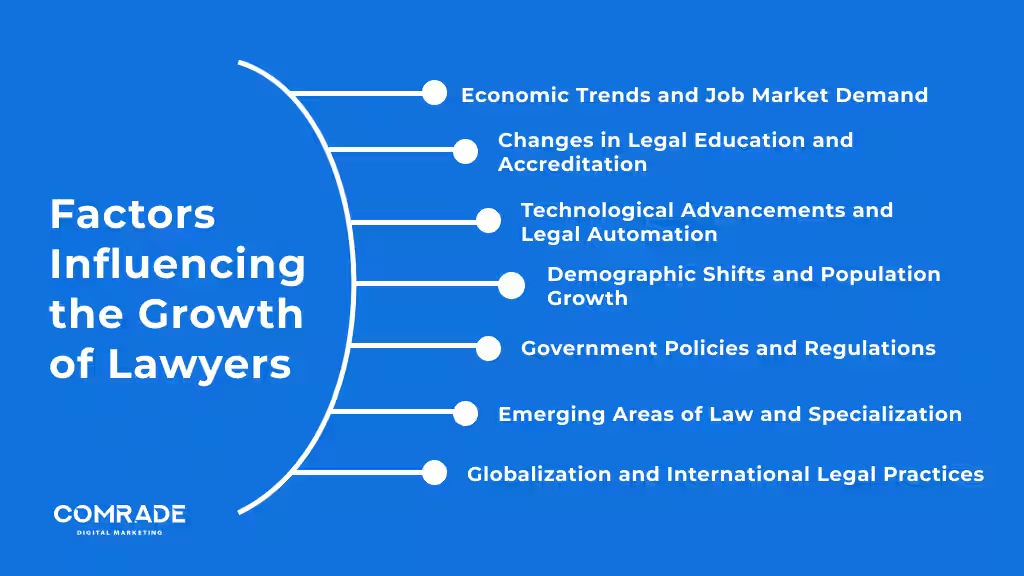Legal professionals are at the heart of the American justice system, influencing everything from corporate policies to individual rights. With a diverse array of specialties—including criminal law, corporate law, family law, and intellectual property—the legal industry remains a cornerstone of modern society. As of early 2024, the U.S. had 1,322,649 active attorneys, according to the American Bar Association (ABA). This figure highlights not only the vast scope of the legal field but also its steady expansion over time.
Understanding how many lawyers practice in the U.S. in 2025 provides valuable insights into market trends, employment opportunities, and the legal sector’s overall health. The numbers can reflect economic shifts, law school graduation rates, and even changes in public policy that influence legal demand. Whether you are a prospective law student, a firm looking to hire, or simply interested in the profession’s impact on society, exploring the latest lawyer population data offers a compelling snapshot of where the legal industry stands today.

Growth of the U.S. Lawyer Population Over Time
The U.S. lawyer population has experienced fluctuating growth over the years, with varying annual changes in the number of resident active attorneys. This table highlights the yearly shifts, showcasing periods of expansion as well as slight declines. The trends reflect evolving legal industry dynamics, which could be influenced by factors like market demand, economic conditions, and changes in legal education or professional opportunities:
| Year | Resident Active Attorney Total | % Change from Prior Year |
|---|---|---|
| 2024 | 1,322,649 | -0.2% |
| 2023 | 1,331,290 | 0.3% |
| 2022 | 1,327,010 | -0.1% |
| 2021 | 1,327,910 | -0.1% |
| 2020 | 1,328,742 | -1.7% |
| 2019 | 1,352,077 | 0.7% |
| 2018 | 1,342,379 | 0.5% |
| 2017 | 1,335,963 | 1.8% |
| 2016 | 1,312,869 | 0.9% |
| 2015 | 1,300,705 | 1.5% |
| 2014 | 1,281,432 | 1.1% |
| 2013 | 1,268,011 | 1.8% |
| 2012 | 1,245,205 | 1.6% |
| 2011 | 1,225,452 | 1.9% |
| 2010 | 1,203,097 | 1.9% |
| 2009 | 1,180,386 | 1.6% |
| 2008 | 1,162,124 | 1.6% |
| 2007 | 1,143,358 | 2.4% |
| 2006 | 1,116,967 | 1.1% |
| 2005 | 1,104,766 | 1.9% |
| 2004 | 1,084,504 | 2.4% |
| 2003 | 1,058,662 | 0.8% |
| 2002 | 1,049,751 | 0.1% |
| 2001 | 1,048,903 | 2.6% |
| 2000 | 1,022,462 | 2.2% |
| 1999 | 1,000,440 | 1.5% |
| 1998 | 985,921 | 3.4% |
| 1997 | 953,260 | 0.7% |
| 1996 | 946,499 | 5.6% |
| 1995 | 896,140 | 3.5% |
| 1994 | 865,614 | 2.3% |
| 1993 | 846,036 | 5.8% |
| 1992 | 799,760 | 2.9% |
| 1991 | 777,119 | 2.8% |
| 1990 | 755,694 | 4.2% |
Overall, the data reveals a steady upward trajectory in the number of U.S. lawyers, punctuated by occasional declines. The fluctuating growth rates demonstrate the legal profession’s resilience and adaptability in response to societal and economic shifts. Understanding these trends helps paint a clearer picture of the legal landscape and may inform future projections for lawyer demand and career opportunities.
Comrade Digital Marketing Agency can help you with the above if you’re unsure how to go about it. Schedule a free consultation.
State-by-State Lawyer Population Breakdown
The legal landscape in the United States is constantly evolving, with the number of lawyers across different states reflecting various trends. This table offers a snapshot of lawyer populations in 2023 and 2024, showing both growth and decline. From states like Montana experiencing notable increases to regions such as Florida and Connecticut facing decreases, understanding these shifts can provide valuable insights into the legal market and regional opportunities:
| State | 2023 | 2024 | % Change from 2023 |
|---|---|---|---|
| Alabama | 12,195 | 12,414 | 1.8% |
| Alaska | 2,268 | 2,294 | 1.1% |
| American Samoa | 55 | 55 | 0.0% |
| Arizona | 15,506 | 15,885 | 2.4% |
| Arkansas | 6,808 | 6,808 | 0.0% |
| California | 170,959 | 175,883 | 2.8% |
| Colorado | 22,802 | 23,249 | 1.9% |
| Connecticut | 21,036 | 18,028 | -16.7% |
| Delaware | 3,058 | 3,058 | 0.0% |
| Dist. of Columbia | 34,734 | 33,129 | -4.8% |
| Florida | 84,594 | 80,080 | -5.6% |
| Georgia | 33,890 | 34,307 | 1.2% |
| Guam | 262 | 262 | 0.0% |
| Hawaii | 4,122 | 4,139 | 0.4% |
| Idaho | 4,098 | 4,076 | -0.5% |
| Illinois | 62,201 | 62,093 | -0.2% |
| Indiana | 15,485 | 15,485 | 0.0% |
| Iowa | 7,258 | 7,190 | -0.9% |
| Kansas | 7,858 | 7,845 | -0.2% |
| Kentucky | 13,600 | 13,632 | 0.2% |
| Louisiana | 19,566 | 19,524 | -0.2% |
| Maine | 4,002 | 3,693 | -8.4% |
| Maryland | 26,020 | 26,020 | 0.0% |
| Massachusetts | 42,635 | 40,075 | -6.4% |
| Michigan | 34,577 | 34,366 | -0.6% |
| Minnesota | 26,065 | 26,065 | 0.0% |
| Mississippi | 6,736 | 6,699 | -0.6% |
| Missouri | 24,613 | 24,679 | 0.3% |
| Montana | 3,201 | 3,603 | 11.2% |
| Nebraska | 5,689 | 5,839 | 2.6% |
| Nevada | 7,498 | 7,563 | 0.9% |
| New Hampshire | 3,451 | 3,461 | 0.3% |
| New Jersey | 40,078 | 39,311 | -2.0% |
| New Mexico | 5,411 | 5,404 | -0.1% |
| New York | 188,341 | 187,656 | -0.4% |
| North Carolina | 26,274 | 26,515 | 0.9% |
| North Dakota | 1,694 | 1,663 | -1.9% |
| North Mariana Islands | 134 | 134 | 0.0% |
| Ohio | 37,717 | 36,488 | -3.4% |
| Oklahoma | 13,415 | 12,245 | -9.6% |
| Oregon | 12,196 | 12,233 | 0.3% |
| Palau | 40 | 43 | 7.0% |
| Pennsylvania | 48,174 | 47,519 | -1.4% |
| Puerto Rico | 14,240 | 13,864 | -2.7% |
| Rhode Island | 4,081 | 3,815 | -7.0% |
| South Carolina | 11,090 | 11,090 | 0.0% |
| South Dakota | 2,027 | 2,042 | 0.7% |
| Tennessee | 19,583 | 19,458 | -0.6% |
| Texas | 96,827 | 98,345 | 1.5% |
| Utah | 8,581 | 8,537 | -0.5% |
| Vermont | 2,198 | 2,198 | 0.0% |
| Virgin Islands | 654 | 654 | 0.0% |
| Virginia | 23,855 | 24,120 | 1.1% |
| Washington | 26,300 | 26,318 | 0.1% |
| West Virginia | 4,673 | 4,600 | -1.6% |
| Wisconsin | 15,192 | 15,172 | -0.1% |
| Wyoming | 1,673 | 1,726 | 3.1% |
| TOTAL | 1,331,290 | 1,322,649 | -0.7% |
The data reveals significant regional variations in lawyer populations, highlighting areas of growth and contraction. While some states saw steady increases, others experienced declines, reflecting broader economic and demographic changes. Monitoring these trends is crucial for law firms and legal professionals aiming to stay ahead of market shifts and adjust their strategies accordingly. The fluctuations can impact everything from legal competition to client demand in different states.
Factors Influencing the Growth of Lawyers in the U.S.
With the U.S. legal profession evolving, more lawyers are expected to join the ranks by 2025. This growth is influenced by factors like the demand for niche legal expertise, advancements in technology, and the changing needs of clients. Interested in learning what drives this upward trend in the number of lawyers? Keep reading as we explore the factors that will shape the legal profession in the coming years.

1. Economic Trends and Job Market Demand
Economic factors play a pivotal role in the demand for legal services. A growing economy often correlates with increased business activity, leading to more legal work in areas such as corporate law, mergers and acquisitions, and intellectual property. Conversely, economic downturns may slow hiring in the legal profession as companies tighten their budgets. However, economic volatility can also increase demand for certain areas of law, such as bankruptcy or consumer protection, driving the need for specialized legal expertise.
Broader employment trends also influence job market demand for lawyers. As sectors such as tech and healthcare expand, these industries require lawyers to navigate new regulatory challenges. The gig economy and rise in freelance work have also spurred demand for legal services related to contract law and employment rights. The availability of jobs, compensation rates, and competition within the legal profession all factor into the number of lawyers needed in the market.
2. Changes in Legal Education and Accreditation
Legal education in the U.S. is undergoing significant changes that affect the number of lawyers entering the profession. With increasing student debt, many prospective law students are reassessing whether the investment in legal education is worth the potential return. Law schools are adjusting their curricula to meet the needs of a changing legal landscape, incorporating technology, and interdisciplinary studies into their programs. These shifts can influence both the number of students entering law schools and the types of legal expertise needed.
Additionally, accreditation standards set by the American Bar Association (ABA) influence the quality and scope of legal education. Changes in these standards, including the adoption of more flexible or innovative learning models such as online law degrees, can affect how many lawyers are trained and the skill sets they bring to the workforce. The rise of alternative legal education models outside traditional law schools may also impact the overall growth of lawyers in the U.S.
3. Technological Advancements and Legal Automation
Technological advancements are transforming the legal industry, with automation and AI tools replacing some routine tasks traditionally handled by lawyers. For example, document review, legal research, and contract analysis can now be performed faster and more efficiently using software, reducing the need for large numbers of attorneys in some sectors. As automation continues to improve, firms may require fewer entry-level associates but may still need specialized lawyers to oversee more complex legal matters that machines cannot address.
However, technology is also creating new opportunities for lawyers, particularly in the fields of cybersecurity, intellectual property, and data privacy. The growing use of digital platforms for legal services also opens the door for lawyers to serve a broader range of clients, including those in underserved areas. These technological shifts may result in a redefined role for lawyers, with a greater emphasis on strategic advisory and oversight of automated processes, rather than traditional legal tasks.
4. Demographic Shifts and Population Growth
Demographic shifts and population growth are key drivers of the demand for legal services. As the U.S. population continues to grow and become more diverse, there is an increasing need for lawyers who specialize in immigration, family law, and civil rights to address the unique needs of these communities. Population growth in urban and suburban areas often leads to higher demand for real estate, environmental, and municipal law services, which contributes to the overall need for more lawyers.
At the same time, the aging population is pushing demand for legal services related to estate planning, elder law, and healthcare. The retirement of baby boomers has created a shift in the types of legal services required, and law firms are adjusting their practices accordingly. This demographic change indicates a growing need for lawyers who can cater to an aging population, influencing the future landscape of legal careers.

5. Government Policies and Regulations
Government policies and regulations play a significant role in shaping the demand for legal professionals. Changes in federal, state, and local regulations can create new legal challenges, driving the need for lawyers to navigate complex legal landscapes. For example, shifts in environmental policy, labor laws, or healthcare regulations often require new legal expertise, creating job opportunities for lawyers. Additionally, government funding for legal services, such as public defenders or legal aid organizations, can influence the overall size of the legal workforce.
On the other hand, regulatory barriers to entry, such as the costs and requirements of passing the bar exam, can limit the number of new lawyers entering the profession. Efforts to reform the legal industry, including initiatives to reduce barriers to legal practice and broaden access to justice, could lead to a more diverse and expansive legal workforce. Government policies thus play an essential role in both promoting and restricting the growth of legal professionals.
6. Emerging Areas of Law and Specialization
As the legal landscape evolves, new areas of specialization are emerging, influencing the growth of lawyers in the U.S. One prominent trend is the rise of technology law, particularly in fields like artificial intelligence, blockchain, and cryptocurrency. Lawyers are needed to navigate the evolving regulatory frameworks in these areas, creating opportunities for new legal careers. Environmental law is also growing in importance, driven by increasing concerns over climate change and sustainability.
Other emerging fields include space law, health technology law, and privacy law, all of which are expanding due to advancements in technology and the global need for new legal frameworks. As these new practice areas become more critical, lawyers who specialize in these fields will be in high demand, contributing to the overall growth of the legal profession. The diversification of legal specialties ensures that the profession remains dynamic and adaptable to the changing needs of society.
7. Globalization and International Legal Practices
Globalization is another key factor influencing the growth of lawyers in the U.S. As businesses expand their operations internationally, the demand for lawyers who can navigate cross-border legal issues has increased. U.S. firms are hiring lawyers with expertise in international trade, foreign investment, and international dispute resolution to serve clients with global interests. This trend has led to an increase in the number of lawyers specializing in international law, fostering growth in the legal profession.

Moreover, U.S. lawyers are increasingly participating in international legal practices, collaborating with firms in other countries on multinational cases and transactions. The globalization of legal services also means that U.S. lawyers must stay current with international legal standards and frameworks, such as the European Union’s General Data Protection Regulation (GDPR). As international legal issues become more complex, U.S. law firms are likely to see continued growth in this area, further diversifying the role of lawyers in a globalized legal market.
Conclusion
The number of lawyers in the U.S. continues to grow in 2025, making the legal industry more competitive than ever. With more attorneys entering the field and established firms expanding their services, standing out from the crowd requires more than just experience—it demands a strong digital presence, effective marketing, and a data-driven approach to client acquisition. If your firm isn’t leveraging modern marketing strategies, you could be losing potential clients to competitors who are investing in SEO, PPC, and conversion-optimized websites.
At Comrade Digital Marketing, we specialize in helping law firms attract, convert, and retain clients through tailored digital marketing solutions. Whether you need a high-performing website, a strategic content plan, or expert PPC management, our team is here to help you stay ahead of the competition. Don’t let your firm get lost in the growing legal landscape—contact Comrade Digital Marketing today and let’s discuss how we can elevate your firm’s online presence and drive real results.
Frequently Asked Questions
-
How many lawyers are expected to be in the U.S. in 2025?
As of January 1, 2024, there were approximately 1,322,649 active lawyers in the United States. The U.S. Bureau of Labor Statistics projects a 5% growth in lawyer employment from 2023 to 2033, which is in line with the average growth rate across all occupations. Applying this growth rate, the number of lawyers in the U.S. is expected to reach approximately 1,350,000 by the end of 2025. This increase will likely correspond with a rise in how many law firms operate nationwide.
-
How does the number of lawyers in the U.S. compare to other countries?
In comparison, Brazil has about 1,032,000 lawyers, equating to one lawyer per 194 people, the highest ratio globally. The United Kingdom has approximately 158,000 solicitors, resulting in one lawyer per 400 people. The U.S. has one lawyer per 256 people, indicating a higher lawyer-to-population ratio than the UK but lower than Brazil.
-
What types of law have the most lawyers practicing in the U.S.?
In the United States, lawyer statistics show a wide range of practice areas within the legal profession. Law firm demographic statistics indicate that corporate law, criminal law, family law, personal injury law, and intellectual property law are among the most common fields. The demand for legal services in these areas often correlates with societal needs and economic activities, with exactly how many lawyers specialize in each area varying based on factors such as population and market conditions.

